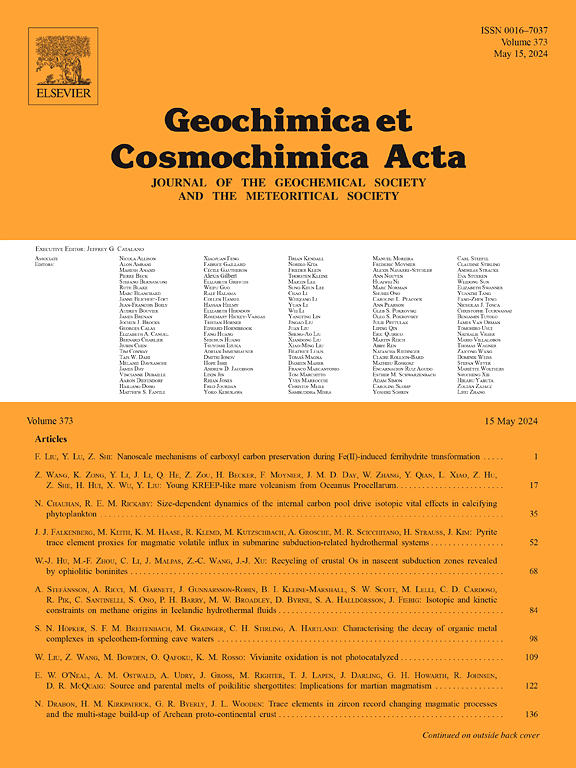Theoretical and experimental constraints on hydrogen isotope equilibrium in C1-C5 alkanes
IF 4.5
1区 地球科学
Q1 GEOCHEMISTRY & GEOPHYSICS
引用次数: 0
Abstract
Stable isotope ratios of C1–C5 alkanes, the major constituents of subsurface gaseous hydrocarbons, can provide valuable insights on their origins, transport, and fates. Equilibrium isotope effects are fundamental to interpreting stable isotope signatures, as recognition of them in natural materials indicates reversible processes and constrains the temperatures of equilibrated systems. Hydrogen isotope equilibrium of C1–C5 alkanes is of particular interest because evidence shows that alkyl H can undergo isotopic exchange with coexisting compounds under subsurface conditions. We present the results of a combined experimental and theoretical effort to determine equilibrium hydrogen isotope distributions in mixtures of these hydrocarbon compounds. We created two mixtures: one with C1, C2 and C3 (where C1 indicates methane, C2 ethane, etc., hereinafter called ‘C1–C3 mixture’) and another one with C2, C3, iC4, nC4, iC5 and nC5 (hereinafter called ‘C2–C5 mixture’); in both cases, the mixtures were created to start out of hydrogen isotope equilibrium. We tested the performance of several metal catalysts as aids to H isotopic exchange by exposing these mixtures to different metal catalysts at 100 or 200 °C and analyzing the compound-specific hydrogen isotope ratios of the product gases. The C1–C3 mixture exchanged hydrogen isotopes among the starting gas components rapidly in the presence of Ru/Al2O3 at 200 °C. The isotope ratios reach a steady-state (presumably equilibrium) after 72 h of heating (up to 120 h). The hydrogen isotopic ratios of alkanes in the C2–C5 mixture shifted significantly in the presence of Rh/Al2O3 at 100 °C and C3-C5 compounds approached steady state after 70 h, whereas C2 had not yet reached a steady state D/H ratio after 216 h of heating. We evaluated the reaction progress of isotope exchange for each compound as a function of time with a reaction-network model informed by constraints on chemical kinetics. The model indicates that C3, iC4, nC4, iC5 and nC5 in the C2-C5 mixture reached internal isotope equilibrium after 70 h, hence we used their values to calculate experimental equilibrium results. We also calculated equilibrium isotope fractionations with the Bigeleisen-Mayer theorem using vibrational frequencies computed from the density functional theory (B3LYP/aug-cc-pVTZ). We included torsional conformers and explicit H positions in the calculations. We found that the experimental results from both the 200 ˚C C1–C3 experiment and 100 ˚C C2–C5 experiment are consistent with theoretical equilibrium results within experimental uncertainty. Additionally, our reaction-network model for catalyzed hydrogen isotope exchange between alkanes succeeded in fitting our experimental results. This modeling framework can be adjusted to simulate exchange in natural settings for constraining temperature histories and sources of natural gases.
C1-C5 烷烃中氢同位素平衡的理论和实验约束
C1-C5 烷烃是地表下气态碳氢化合物的主要成分,其稳定同位素比可以为了解它们的起源、迁移和命运提供宝贵的信息。平衡同位素效应是解释稳定同位素特征的基础,因为在天然物质中认识到平衡同位素效应表明过程是可逆的,并能限制平衡系统的温度。C1-C5 烷烃的氢同位素平衡尤其令人感兴趣,因为有证据表明,在地下条件下,烷基 H 可以与共存化合物发生同位素交换。为了确定这些烃类化合物混合物中的平衡氢同位素分布,我们展示了实验和理论相结合的研究成果。我们创建了两种混合物:一种含有 C1、C2 和 C3(其中 C1 表示甲烷,C2 表示乙烷等,以下称为 "C1-C3 混合物"),另一种含有 C2、C3、iC4、nC4、iC5 和 nC5(以下称为 "C2-C5 混合物");在这两种情况下,创建的混合物都是从氢同位素平衡开始的。我们测试了几种金属催化剂作为氢同位素交换辅助剂的性能,方法是在 100 或 200 °C 下将这些混合物暴露于不同的金属催化剂中,并分析产物气体中特定化合物的氢同位素比。在 Ru/Al2O3 的存在下,C1-C3 混合物在 200 ℃ 下迅速交换了起始气体组分中的氢同位素。加热 72 小时后(最长 120 小时),同位素比达到稳态(推测为平衡)。C2-C5 混合物中烷烃的氢同位素比在 Rh/Al2O3 存在于 100 °C时发生了显著变化,C3-C5 化合物在 70 小时后接近稳态,而 C2 在加热 216 小时后尚未达到稳态 D/H 比。我们根据化学动力学约束条件,利用反应网络模型评估了每种化合物的同位素交换反应进程与时间的函数关系。模型显示,C2-C5 混合物中的 C3、iC4、nC4、iC5 和 nC5 在 70 小时后达到内部同位素平衡,因此我们使用它们的值来计算实验平衡结果。我们还利用密度泛函理论(B3LYP/aug-cc-pVTZ)计算出的振动频率,利用比格列森-迈耶定理计算了平衡同位素分馏。我们在计算中加入了扭转构象和明确的 H 位置。我们发现,来自 200 ˚C C1-C3 实验和 100 ˚C C2-C5 实验的实验结果与理论平衡结果一致,且在实验不确定性范围内。此外,我们的烷烃间催化氢同位素交换反应网络模型成功地拟合了实验结果。这一建模框架可用于模拟自然环境中的交换,以确定温度历史和天然气的来源。
本文章由计算机程序翻译,如有差异,请以英文原文为准。
求助全文
约1分钟内获得全文
求助全文
来源期刊

Geochimica et Cosmochimica Acta
地学-地球化学与地球物理
CiteScore
9.60
自引率
14.00%
发文量
437
审稿时长
6 months
期刊介绍:
Geochimica et Cosmochimica Acta publishes research papers in a wide range of subjects in terrestrial geochemistry, meteoritics, and planetary geochemistry. The scope of the journal includes:
1). Physical chemistry of gases, aqueous solutions, glasses, and crystalline solids
2). Igneous and metamorphic petrology
3). Chemical processes in the atmosphere, hydrosphere, biosphere, and lithosphere of the Earth
4). Organic geochemistry
5). Isotope geochemistry
6). Meteoritics and meteorite impacts
7). Lunar science; and
8). Planetary geochemistry.
 求助内容:
求助内容: 应助结果提醒方式:
应助结果提醒方式:


